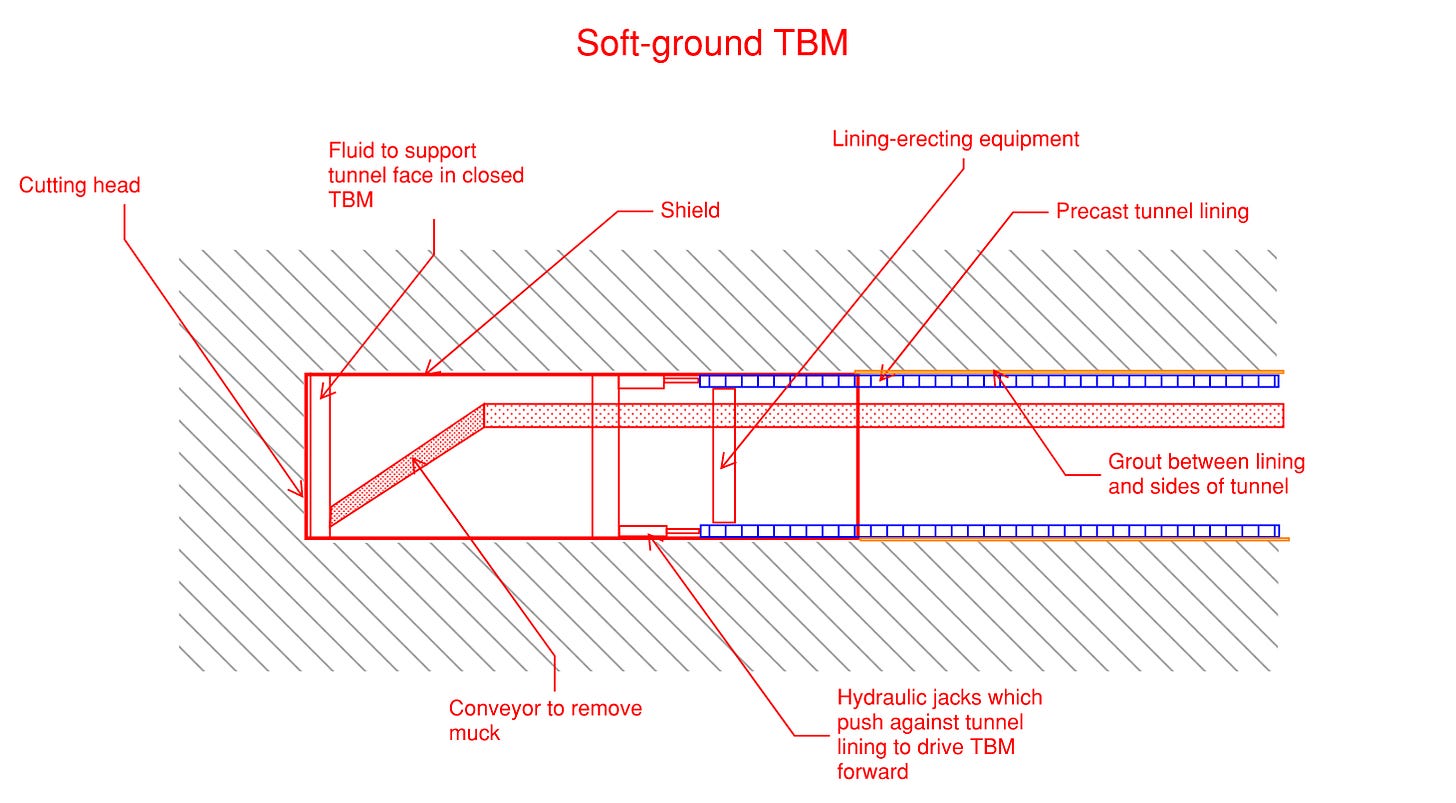From Construction Physics, October 6:
Tunneling is an important technology for modern civilization, as a tunnel is often the only reasonable way to create a direct path between two points. When the Hoosac tunnel was completed in 1875, it turned a difficult, 20-mile railroad route along “precipitous grades” into a direct 5 mile route, connecting Boston with the Upper Hudson Valley. Large infrastructure projects such as hydroelectric dams often require tunnels to function. The Hoover Dam required more than 3 miles of tunnels 56 feet in diameter to divert the Colorado River around the construction site. And a tunnel can be used to create new land beneath dense urban areas, making it possible to build large-scale horizontal infrastructure like sewers or mass transit that wouldn’t be feasible to build above ground.
A common way of building a tunnel today is with a tunnel boring machine (TBM), particularly in urban areas where other construction methods such as drill-and-blast or cut-and-cover would be too disruptive. Of the 89 transit projects around the world that required tunneling in a dataset compiled by Britain Remade, 80 of them used TBMs. But tunnel boring machines are a comparatively modern construction technology. The first successful rock tunneling machines weren’t invented until the 1950s, and into the late 1960s most tunneling was done using other construction methods. But as TBMs have improved, they have increasingly been the method of choice for tunneling through a wider variety of ground conditions. And while many construction tasks have resisted automation and mechanization, tunneling machinery has steadily gotten more automated, to the point where a modern TBM is akin to a mobile factory that burrows through the earth and constructs a tunnel behind it.
What is a tunnel boring machine?
There are a variety of different types of machinery used to excavate tunnels. “Tunnel boring machines” use a rotating cutting head that engages with the entire face of the tunnel at once. This contrasts with something like a roadheader, which uses a much smaller cutter that moves back and forth over the face of the tunnel....*****....(The terminology around TBMs is somewhat non-standard. In some cases, any sort of mechanized tunnel shield gets referred to as a TBM. Other times TBM is used strictly for rock tunneling machines, and don’t include machines that tunnel through soil.)All TBMs share several basic features. At the front, a rotating cutting head excavates the face of the tunnel. Excavated material, known as “muck," passes through openings in the cutting head and is removed by some sort of conveying system. To advance, a TBM uses large hydraulic cylinders to push off against either the excavated sides of the tunnel (in “gripper” TBMs) or against a prefabricated tunnel lining that has been installed around the inside of the excavated tunnel. Gripper TBMs are limited to use in rock, whereas TBMs that push against a segmented tunnel lining can also be used in soft ground. In soft ground, all this equipment is encased in a cylindrical structure known as a “shield," which supports the sides of the tunnel while it's being excavated. In rock, this shield may or may not be used.
TBMs can be further divided by whether some kind of support for the face of the tunnel is required. “Closed” TBMs use a fluid or other material behind the rotating cutting head of the TBM to prevent the face of the tunnel from collapsing, or from water intruding as the tunnel is bored. “Open” TBMs, on the other hand, don’t have this support, and can be used where the tunnel face is strong enough to support itself during excavation and where groundwater intrusion isn’t a problem. The chart below shows this breakdown....
....MUCH MORE
Previously on boring. We've gone from 2016's "Elon Musk Considering A Boring Company" with the strategic thinking involved, through 2017's:
Like the 60 Year Old Prostitutes Dressed As Lady Gaga In the Rue Saint-Denis, Elon Musk's Boring Company May Be More Interesting For the Packaging Than the Product (TSLA)to 2023's:
Elon Musk's Boring Company Gets Approval To Expand Las Vegas Tunnel System To 65 Miles In Length
